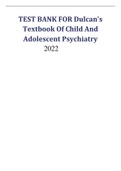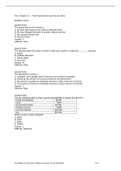TEST BANK FOR Dulcan’s Textbook Of Child And Adolescent Psychiatry 2022 STUDY GUIDE TO CHILD AND ADOLES-
CENT PSYCHIATRY A Companion to Dulcan’s Textbook of Child and Adolescent Psychiatry STUDY GUIDE TO CHILD AND ADOLES-
CENT PSYCHIATRY A Companion to Dulcan’s Textbook of Child and Adolescent Psychiatry Hong Shen, M.D. Clinical Associate Professor of Psychiatry, Department of Psychiatry and Behavioral Sciences University of California, Davis School of Medicine Sacramento, California Robert E. Hales, M.D., M.B.A. Joe P. Tupin Chair, Department of Psychiatry and Behavioral Sciences Interim Director, M.I.N.D. Institute University of California, Davis School of Medicine Sacramento, California Narriman C. Shahr okh Chief Administrative Officer, Department of Psychiatry and Behavioral Sciences University of California, Davis School of Medicine Sacramento, California 2 | Note: The authors have worked to ensure that all information in this publication is accurate at the time of publ i-
cation and consistent with general psychiatric and medical standards, and that information concerning drug dosages, schedules, and routes of administration is accurate at the time of publication and consistent with standards set by the U.S. F ood and Drug Administration and the general medical community. As medical r e-
search and practice continue to advance, however, therapeutic standards may change. Moreover, specific situa-tions may require a specific therapeutic response not included in this publication. For these reasons and be-cause human and mechanical errors sometimes occur, we recommend that readers follow the advice of phys i-
cians directly involved in their care or the care of a member of their family. Publications of American Psychiatric Publishing, Inc. (APPI), represent the views and opinions of the individual authors and do not necessarily represent the policies and opinions of APPI or the American Psychiatric Association. If you would like to buy between 25 and 99 copies of this or any other APPI title, you are eligible for a 20% di s-
count; please contact APPI Customer Service at appi@psych.org or 800- 368-5777. If you wish to buy 100 or more copies of the same title, please email us at bulksales@psych.org for a price quote. Copyright © 2010 American Psychiatric Publishing, Inc. ALL RIGHTS RESERVED Manufactured in the United States of America on acid- free paper 13 12 11 10 09 5 4 3 2 1 ISBN 978 -1-58562- 353-2 First Edition Typeset in Revival BT and Adobe's The Mix American Psychiatric Publishing, Inc. 1000 Wilson Boulevard Arlington, VA 22209- 3901 www.appi.org Contents Preface .............................................................................................................................. xv Questions CHAPTER 1 Assessing Infants and Toddlers .......................................................................................... 1 CHAPTER 2 Assessing the Preschool -Age Child .................................................................................... 2 CHAPTER 3 Assessing the Elementary School –Age Child ..................................................................... 4 CHAPTER 4 Assessing Adolescents ....................................................................................................... 5 CHAPTER 5 Classification of Psychiatric Disorders ................................................................................ 7 CHAPTER 6 The Process of Assessment and Diagnosis ........................................................................ 9 CHAPTER 7 Diagnostic Interviews ........................................................................................................ 11 CHAPTER 8 Rating Scales .................................................................................................................... 13 CHAPTER 9 Pediatric Evaluation and Laboratory Testing .................................................................... 14 CHAPTER 10 Neurological Examination, Electroencephalography, and Neuroimaging ......................... 16 CHAPTER 11 Psychological and Neuropsychological Testing ................................................................ 18 CHAPTER 12 Intellectual Disability (Mental Retardation) ........................................................................ 20 4 | CHAPTER 13 Autism Spectrum Disorders .............................................................................................. 22 CHAPTER 14 Developmental Disorders of Learning, Communication, and Motor Skills ........................ 23 CHAPTER 15 Attention -Deficit/Hyperactivity Disorder ............................................................................. 25 CHAPTER 16 Oppositional Defiant Disorder and Conduct Disorder ....................................................... 27 CHAPTER 17 Substance Abuse and Addictions ..................................................................................... 28 CHAPTER 18 Depression and Dysthymia ............................................................................................... 30 CHAPTER 19 Bipolar Disorder ................................................................................................................ 32 CHAPTER 20 Generalized Anxiety Disorder, Specific Phobia, Panic Disorder, Social Phobia, and Selective Mutism ................................................................................ 34 CHAPTER 21 Separation Anxiety Disorder and School Refusal ............................................................. 36 CHAPTER 22 Posttraumatic Stress Disorder .......................................................................................... 38 CHAPTER 23 Obsessive- Compulsive Disorder ....................................................................................... 39 CHAPTER 24 Early -Onset Schizophrenia ............................................................................................... 41 CHAPTER 25 Obesity .............................................................................................................................. 43 CHAPTER 26 Anorexia Nervosa and Bulimia Nervosa ........................................................................... 45 CHAPTER 27 Tic Disorders ..................................................................................................................... 47 CHAP TER 28 Elimination Disorders ........................................................................................................ 48 CHAPTER 29 Sleep Disorders ................................................................................................................ 49 CHAPTER 30 Evidence- Based Practices ................................................................................................ 51 CHAPTER 31 Child Abuse and Neglect .................................................................................................. 52 CHAPTER 32 HIV and AIDS ................................................................................................................... 53 CHAPTER 33 Bereavement and Traumatic Grief .................................................................................... 54 CHAPTER 34 Ethnic, Cultural, and Religious Issues .............................................................................. 56 CHAPTER 35 Youth Suicide .................................................................................................................... 58 CHAPTER 36 Gender Identity and Sexual Orientation ............................................................................ 60 CHAPTER 37 Aggression and Violence .................................................................................................. 62 CHAPTER 38 Genetics: Fundamentals Relevant to Child and Adolescent Psychiatry ............................ 64 CHAPTER 39 Psychiatric Emergencies ................................................................................................... 66 CHAPTER 40 Family Transitions: Challenges and Resilience ................................................................ 68 CHAPTER 41 Psychiatric Aspects of Chronic Physical Disorders ........................................................... 70 CHAPTER 42 Children of Parents With Psychiatric and Substance Abuse Disorders ............................ 72 6 | CHAPTER 43 Legal and Ethical Issues ................................................................................................... 74 CHAPTER 44 Telepsychiatry ................................................................................................................... 75 CHAPTER 45 Principles of Psychopharmacology ................................................................................... 76 CHAPTER 46 Medications Used for Attention- Deficit/Hyperactivity Disorder .......................................... 78 CHAPTER 47 Antidepressants ................................................................................................................ 79 CHAPTER 48 Mood Stabilizers ............................................................................................................... 81 CHAPTER 49 Antipsychotic Medications ................................................................................................. 83 CHAPTER 50 Alpha- Adrenergics, Beta- Blockers, Benzodiazepines, Buspirone, and Desmopressin ..... 85 CHAPTER 51 Medications Used for Sleep .............................................................................................. 87 CHAPTER 52 Electroconvulsive Therapy, Transcranial Magnetic Stimulation, and Deep Brain Stimulat ion .............................................................................................. 88 CHAPTER 53 Individual Psychotherapy .................................................................................................. 90 CHAPTER 54 Parent Counseling, Psychoeducation, and Parent Support Groups ................................. 91 CHAPTER 55 Behavioral Parent Training ............................................................................................... 93 CHAPTER 56 Family Therapy ................................................................................................................. 94 CHAPTER 57 Interpersonal Psychotherapy for Depressed Adolescents ................................................ 95 CHAPTER 58 Cognitive -Behavioral Treatment for Anxiety Disorders ..................................................... 97 CHAPTER 59 Cognitive -Behavioral Therapy for Depression .................................................................. 99 CHAPTER 60 Motivational Interviewing ................................................................................................. 101 CHAPTER 61 Systems of Care, Wraparound Services, and Home- Based Services ............................ 102 CHAPTER 6 2 Milieu Treatment: Inpatient, Partial Hospitalization, and Residential Programs .............. 104 CHAPTER 63 School -Based Interventions ............................................................................................ 106 CHAPTER 64 Collaborating With Primary Care .................................................................................... 108 CHAPTER 65 Juvenile Justice .............................................................................................................. 110 Answer Guide CHAPTER 1 Assessing Infants and Toddl ers ...................................................................................... 111 CHAPTER 2 Assessing the Preschool -Age Child ................................................................................ 114 CHAPTER 3 Assessing the Elementary School –Age Child ................................................................. 118 CHAPTER 4 Assessing Adolescents ................................................................................................... 121 CHAPTER 5 Classification of Psychiatric Disorders ............................................................................ 125 CHAPTER 6 The Process of Assessment and Diagnosis .................................................................... 128 8 | CHAPTER 7 Diagnostic Interviews ...................................................................................................... 131 CHAPTER 8 Rating Scales .................................................................................................................. 134 CHAPTER 9 Pediatric Evaluation and Laboratory Testing .................................................................. 138 CHAPTER 10 Neurological Examination, Electroencephalography, and Neuroimaging ....................... 143 CHAPTER 11 Psychological and Neuropsychological Test ing .............................................................. 146 CHAPTER 12 Intellectual Disability (Mental Retardation) ...................................................................... 149 CHAPTER 13 Autism Spectrum Disorders ............................................................................................ 153 CHAPTER 14 Developmental Disorders of Learning, Communication, and Motor Skills ...................... 157 CHAPTER 15 Attention -Deficit/Hyperactivity Disorder ........................................................................... 160 CHAPTER 16 Oppositional Defiant Disorder and Conduct Disorder ..................................................... 165 CHAPTER 17 Substance Abuse and Addictions ................................................................................... 168 CHAPTER 18 Depression and Dysthymia ............................................................................................. 171 CHAPTER 19 Bipolar Disorder .............................................................................................................. 175 CHAPTER 20 Generalized Anxiety Disorder, Specific Phobia, Panic Disorder , Social Phobia, and Selective Mutism .............................................................................. 178 CHAPTER 21 Separation Anxiety Disorder and School Refusal ........................................................... 183





